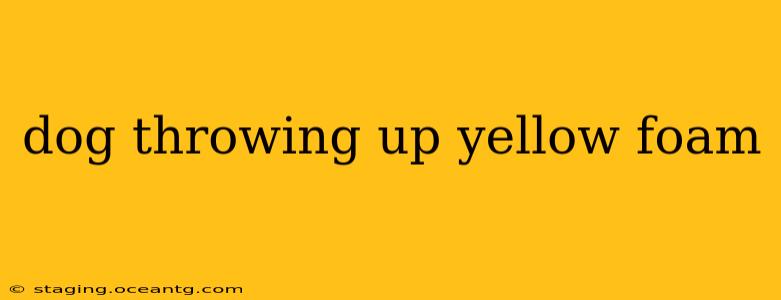Seeing your dog vomit, especially yellow foam, is understandably alarming. This isn't always a cause for immediate panic, but it's crucial to understand the potential causes and know when veterinary attention is necessary. This guide will help you decipher the meaning behind your dog's yellow foam vomit and equip you with the knowledge to take appropriate action.
What Causes Yellow Foam Vomiting in Dogs?
Yellow foam vomit in dogs can stem from several factors, ranging from minor dietary indiscretions to more serious medical conditions. The color often indicates bile, a digestive fluid produced by the liver. Here are some common causes:
-
Empty Stomach: If your dog vomits yellow foam first thing in the morning, it's often because their stomach is empty, leading to bile being present in the vomit. This is generally not a cause for concern unless it's accompanied by other symptoms.
-
Dietary Indiscretion: Eating something they shouldn't have—like spoiled food, garbage, or non-food items—can trigger vomiting. The yellow foam may be mixed with undigested food or other materials.
-
Gastritis (Inflammation of the Stomach): This inflammation can be caused by various factors, including infections, dietary irritants, or medications. Gastritis can result in vomiting, often including yellow foam.
-
Inflammatory Bowel Disease (IBD): IBD is a chronic condition causing inflammation of the digestive tract. Symptoms can include vomiting (including yellow foam), diarrhea, weight loss, and lethargy.
-
Pancreatitis (Inflammation of the Pancreas): This serious condition can manifest with vomiting, often containing bile, abdominal pain, and lethargy.
-
Liver Disease: Problems with the liver can affect bile production and lead to vomiting, including yellow foam. Other symptoms of liver disease can include jaundice (yellowing of the skin and eyes), lethargy, and weight loss.
-
Obstructions: A blockage in the digestive tract, such as from a foreign body, can cause severe vomiting, often including yellow foam.
-
Infections: Viral or bacterial infections can also trigger vomiting with yellow foam.
-
Parasites: Certain intestinal parasites can cause vomiting and other gastrointestinal upset.
Is Yellow Foam Vomit Always Serious?
Not necessarily. As mentioned, vomiting yellow foam on an empty stomach is often benign. However, repeated vomiting, vomiting that's persistent, or vomiting accompanied by other symptoms should always warrant a veterinary checkup.
When Should I Take My Dog to the Vet?
You should consult a veterinarian immediately if your dog exhibits any of the following alongside yellow foam vomit:
- Lethargy or weakness: A significant decrease in energy levels is a red flag.
- Loss of appetite: Refusal to eat is a concerning sign.
- Diarrhea: This indicates a broader gastrointestinal issue.
- Abdominal pain: Signs of pain, such as whimpering, guarding their abdomen, or reluctance to move, require urgent veterinary attention.
- Dehydration: Signs of dehydration include sunken eyes, dry gums, and lethargy.
- Blood in the vomit: This is a serious symptom and requires immediate veterinary care.
- Persistent or repeated vomiting: If your dog continues to vomit, even after a few hours, seek veterinary help.
- Fever: A high temperature often signifies an infection.
What Can I Do If My Dog Throws Up Yellow Foam?
If your dog vomits yellow foam and shows no other symptoms, you can try the following:
- Withhold food for 12-24 hours: This allows their stomach to settle.
- Offer small amounts of water: Ensure they stay hydrated, but don't force them to drink if they're not thirsty.
- Observe closely: Monitor your dog for any changes in behavior or additional symptoms.
- Provide a bland diet: Once the vomiting has stopped, offer a bland diet of boiled chicken and rice for a day or two.
Important Note: This information is for educational purposes only and should not be considered a substitute for professional veterinary advice. Always consult your veterinarian for any concerns about your dog's health.
How Can I Prevent Future Episodes?
While you can't prevent all instances of vomiting, you can reduce the risk by:
- Feeding a high-quality diet: Choose food formulated for your dog's age and breed.
- Avoiding table scraps: Keep food items out of your dog's reach.
- Preventing access to garbage: Secure your trash cans.
- Regular veterinary check-ups: Early detection of underlying health problems is crucial.
- Monitoring for parasites: Regular parasite prevention is essential.
This comprehensive guide provides a detailed understanding of yellow foam vomit in dogs, equipping pet owners with the knowledge to act appropriately and ensure their canine companions receive timely and proper care. Remember, when in doubt, always consult your veterinarian.
